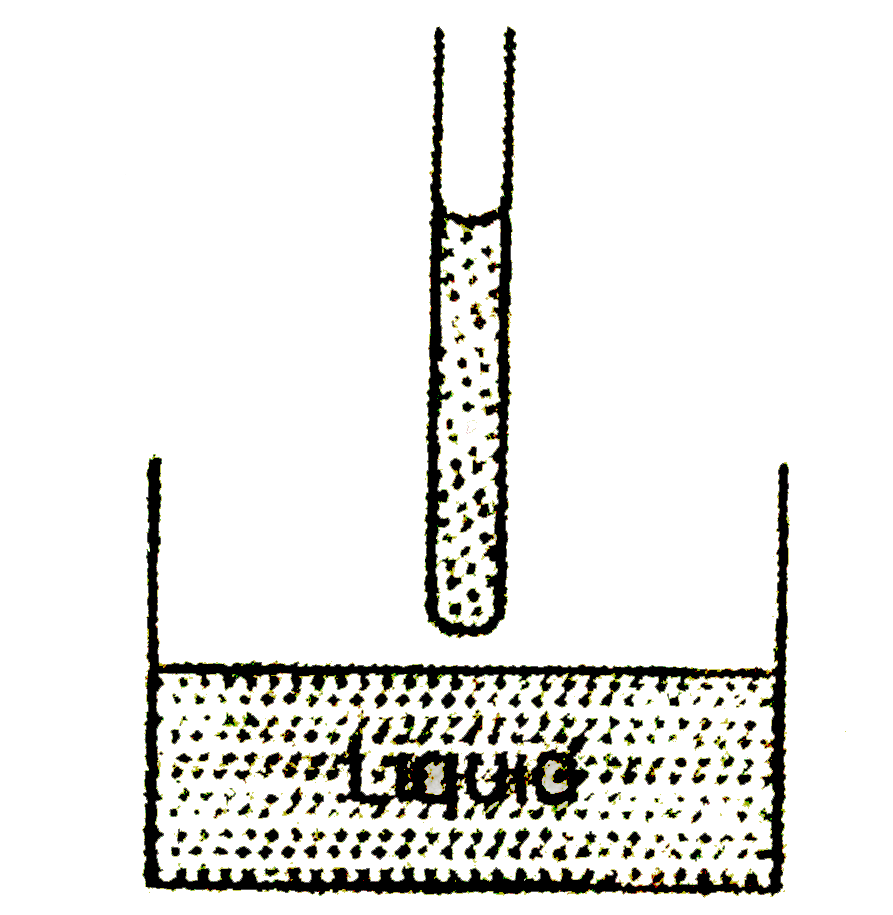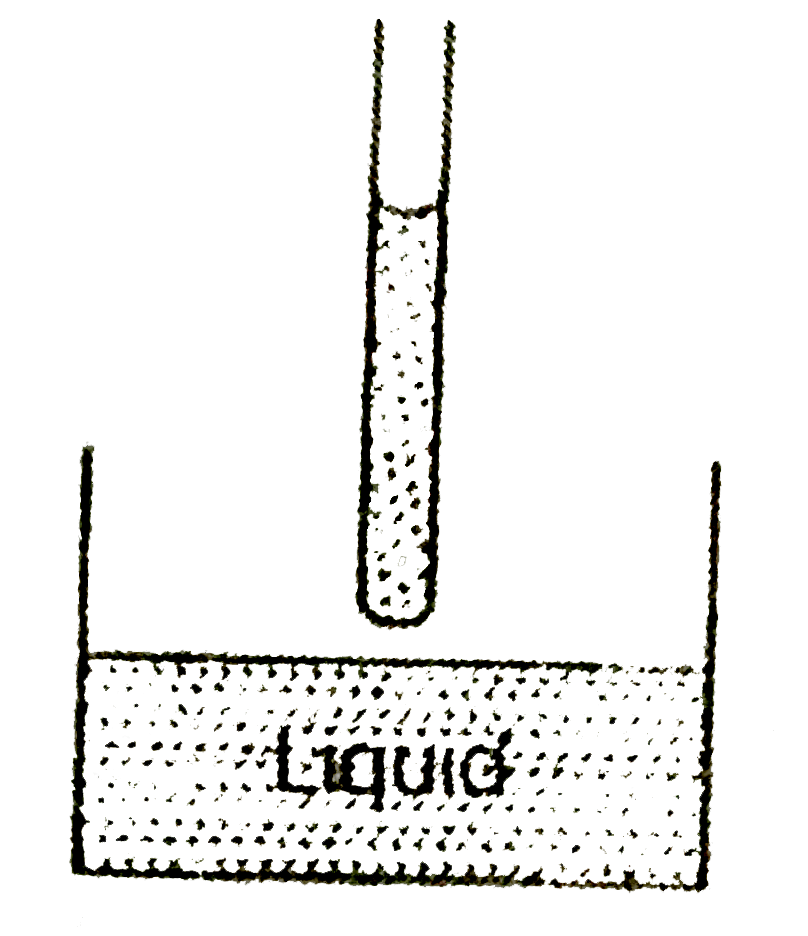A capillary tube of radius r is lowered into a liquid of surface tension T and density ρ. Given angle of contact =0∘.
What is the potential energy acquired by the liquid in the capillary?
πT22ρg
T22ρg
T2ρg
2πT2ρg
The correct Answer is:D
To find the potential energy acquired by the liquid in a capillary tube, we can follow these steps:
Step 1: Determine the height of the liquid column
The height h to which the liquid rises in the capillary tube can be calculated using the formula:
h=2Tcos(θ)ρgr
where:
- T is the surface tension of the liquid,
- θ is the contact angle (which is 0∘ in this case, so cos(0)=1),
- ρ is the density of the liquid,
- g is the acceleration due to gravity,
- r is the radius of the capillary tube.
Since the contact angle is 0∘, the formula simplifies to:
h=2Tρgr
Step 2: Calculate the mass of the liquid in the capillary
The volume V of the liquid that rises in the capillary tube can be calculated as:
V=πr2h
The mass m of the liquid is given by:
m=ρV=ρπr2h
Step 3: Find the center of mass of the liquid column
The center of mass of the liquid column is at a height of h2 from the bottom of the capillary tube.
Step 4: Calculate the potential energy
The potential energy PE acquired by the liquid can be calculated using the formula:
PE=mghcm
where hcm=h2 is the height of the center of mass. Substituting the expression for mass m and height hcm:
PE=(ρπr2h)g(h2)
Substituting h=2Tρgr:
PE=(ρπr2⋅2Tρgr)g⎛⎝2Tρgr2⎞⎠
Step 5: Simplify the expression
Substituting and simplifying:
PE=(2πrTg)g(Tρgr)
PE=2πT2ρg
Final Result
Thus, the potential energy acquired by the liquid in the capillary tube is:
PE=2πT2ρg
The height h to which the liquid rises in the capillary tube can be calculated using the formula:
h=2Tcos(θ)ρgr
where:
- T is the surface tension of the liquid,
- θ is the contact angle (which is 0∘ in this case, so cos(0)=1),
- ρ is the density of the liquid,
- g is the acceleration due to gravity,
- r is the radius of the capillary tube.
h=2Tρgr
The volume V of the liquid that rises in the capillary tube can be calculated as:
V=πr2h
The mass m of the liquid is given by:
m=ρV=ρπr2h
The center of mass of the liquid column is at a height of h2 from the bottom of the capillary tube.
The potential energy PE acquired by the liquid can be calculated using the formula:
PE=mghcm
where hcm=h2 is the height of the center of mass. Substituting the expression for mass m and height hcm:
PE=(ρπr2h)g(h2)
Substituting h=2Tρgr:
PE=(ρπr2⋅2Tρgr)g⎛⎝2Tρgr2⎞⎠
Substituting and simplifying:
PE=(2πrTg)g(Tρgr)
PE=2πT2ρg
Thus, the potential energy acquired by the liquid in the capillary tube is:
PE=2πT2ρg
Topper's Solved these Questions
- PROPERTIES OF MATTERBOOK - DC PANDEY ENGLISHCHAPTER - PROPERTIES OF MATTEREXERCISE - Matrix Matching
12 Videos
- PROPERTIES OF MATTERBOOK - DC PANDEY ENGLISHCHAPTER - PROPERTIES OF MATTEREXERCISE - Integer
8 Videos
- PROPERTIES OF MATTERBOOK - DC PANDEY ENGLISHCHAPTER - PROPERTIES OF MATTEREXERCISE - More than one option is correct
21 Videos
- PROJECTILE MOTIONBOOK - DC PANDEY ENGLISHCHAPTER - PROJECTILE MOTIONEXERCISE - Level - 2 Subjective
10 Videos
- RAY OPTICSBOOK - DC PANDEY ENGLISHCHAPTER - RAY OPTICSEXERCISE - Integer type q.
14 Videos
Similar Questions
Choose the correct option:
A capillary tube of radius r is lowered into a liquid of surface tension T and density ρ. Given angle of contact =0∘.
The work done by surface tension will be
View SolutionA tube of radius r and sufficient height is dipped in a liquid of surface tension S and density ρ. Heat developed upto steady state will be
Note: θ is the contact angle
View SolutionIf a capillary tube is dipped and the liquid levels inside and outside the tube are same. Then the angle of contact is
View SolutionA long glass capillary (radius R) is taken out of liquid (surface tension S and density ρ) in vertical position. Angle of contact everywhere is zero. Atmospheric pressure is P0. It is observed that the capillary retains some liquid.

The length of liquid column retained in the capillary is
View SolutionA long glass capillary (radius R) is taken out of liquid (surface tension S and density ρ) in vertical position. Angle of contact everywhere is zero. Atmospheric pressure is P0. It is observed that the capillary retains some liquid.

The radius of curvature of meniscus at the bottom of tube is
View SolutionLower end of a capillary tube of radius 10−3 m is dipped vertically into a liquid. Surface tension of liquid is 0.5 N/m and specific gravity of liquid is 5. Contact angle between liquid and material of capillary tube is 120∘. Choose the correct options (use g = 10m/s2)
View SolutionDue to capillary action, a liquid will rise in a tube, if the angle of contact is
View SolutionA capillary tube of radius 0.6 mm is dipped vertically in a liquid of surface tension 0.04Nm−1and relative density 0.8 . Calculate the height of capillary rise if the angle of contact is 15∘.
View SolutionA liquid of density ρ and surface tension σ rises in a capillary tube of diameter d. Angle of contact between the tube and liquid is zero.
In the above problem, the increase in gravitational potential energy of the liquid due to rise in the capillary is :
View SolutionA liquid of density ρ and surface tension σ rises in a capillary tube of diameter d. Angle of contact between the tube and liquid is zero. The weight of the liquid in the capillary tube is:
View Solution
